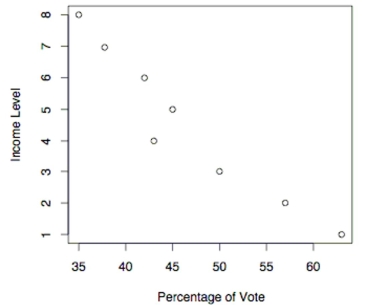The following scatterplot shows the percentage of the vote a candidate received in the 2004 senatorial elections according to the voter's income level based on an exit poll of voters conducted by CNN. The income levels 1-8 correspond to the following income classes: 1=Under $15,000; 2=$15-30,000; 3=$30-50,000; 4=$50-75,000; 5=$75-100,000; 6=$100-150,000;
7=$150-200,000; 8=$200,000 or more. 
-Use the election scatterplot to determine whether there is a correlation between percentage of vote and income level at the 0.01 significance level with a null hypothesis of
Definitions:
Current Assets
Assets that are expected to be converted into cash, sold, or consumed within one year or the normal operating cycle of the business, whichever is longer.
Balance Sheet
A financial statement that displays the company's assets, liabilities, and shareholders' equity at a specific point in time, offering insight into its fiscal health.
Direct Write-Off Method
A method of accounting for bad debts that charges the amount of an outstanding account directly to the expense account at the time it is deemed uncollectable.
Accounting Equation
A fundamental principle of accounting that equates assets with the sum of liabilities and shareholders' equity (Assets = Liabilities + Equity).
Q7: <img src="https://d2lvgg3v3hfg70.cloudfront.net/TB7898/.jpg" alt=" " class="answers-bank-image d-block" rel="preload"
Q7: Describe the test of homogeneity. What characteristic
Q8: Using the data below and a
Q15: Use the Minitab display to test
Q38: An observed frequency distribution of exam
Q49: Define statistically stable (or "within statistical control").
Q83: A placement test is required for
Q84: Use the data in the given table
Q109: Given that the rank correlation coefficient, rs,
Q133: Listed below are the amounts of